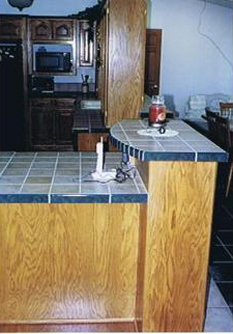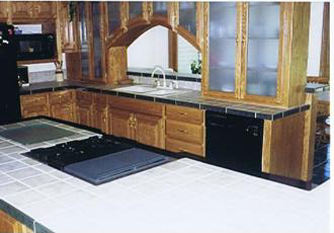Ceramic Tile
Ceramic tile is not as difficult to select as other flooring and the atmospheric constraints are not as relevant. Humidity doesn't matter. Temperature doesn't matter as long as it's above freezing. Most ceramic tile cannot be used outside. Any ceramic that absorbs over .5% water will probably split or crack. Only a porcelain tile should be used outside.

Lets look at how each, ceramic and porcelain is made, and what the advantages of each are. A ceramic tile is simple a clay glazed and fired at a high temperature. Every time the tile is fired, it becomes weaker. A once fired ceramic, called a monacutura, is the hardest ceramic made and will be the most expensive. Ceramics are losing in popularity quickly as porcelain with it's many advantages takes over. I believe that within the next five years, ceramic tile will become virtually a material of the past.
The most important thing to remember about ceramic is that a FLOOR tile can be used on the walls, but a WALL tile cannot be used on the floor. Today, although sizes are used up to 20"x20", the 13"x13" remains king and is the most reasonable priced. The smaller the tile or the larger the tile, the more expensive. The 13"x13" is your best tile value. 
A porcelain is simple a ceramic tile made with a dense clay. It is stronger than ceramic and because of the dense clay body, will not absorb as much moisture as the ceramic does. Porcelain is becoming King. It can be installed indoors or out, has very low moisture absorption (.5%), is harder than ceramic, and offers all of the color and styling of ceramic tile. Most porcelain tiles are not classified wall and floor. They are all rated for floor and wall usage.
The last thing to consider is heat for your floor.

That's the downside of ceramic or porcelain in a Northern climate is they are darn cold. Today, it is becoming very popular to "radiant heat" a floor. This is either a matt or a continuous wire woven in an s grid under the tile floor. The tile is then installed over it. A wall mounted thermostat or thermostat and timer control the temperature. I have a real problem with this system. I have seen several cases where the wire is broken while installing the system or shorts and breaks after it is used a while. When this happens the only fix is to tear up the floor and re-do the system. I far prefer the hot water heating systems, they are virtually fail proof.
Tile flooring; tough, easy to clean, easy to repair.
It is a very good value and in fact, adds value to your home. Caution! It is also a slippery and dangerous floor so look for one with good slip resistance, called the "coefficient of friction". The rougher the safer. Beautiful patterns that can be done with no other flooring are a snap with tile. Let your flooring professional help you bring your design and home to life.